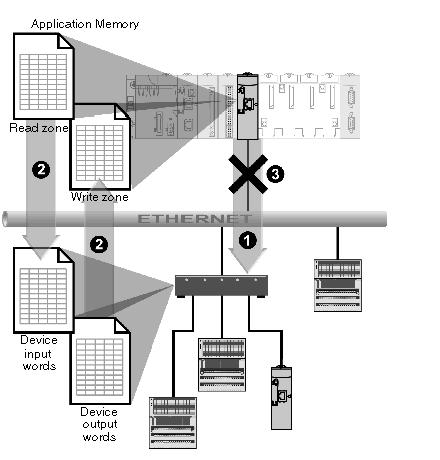The I/O Scanner is used to periodically:
The I/O Scanner is used to periodically read or write remote inputs and outputs on the Ethernet network without specific programming.
NOTE: I/O scanning is not supported by the Ethernet port of BMX P34 20x0 CPUs.
This service comprises the following essential elements:
-
read zone: the values of remote inputs
-
write zone: the values of remote outputs
-
scanning periods: independent of the cycle and specific to each remote device
During operation, the module:
-
manages the connections with each remote device
-
scans inputs and copies their values into the configured word zone
-
scans outputs and copies their values from the configured %MW word zone
-
reports status words so that correct operation of the service can be monitored by the PLC application
-
applies the preconfigured fallback values (in the event of a communication problem)
-
enables or disables each entry in the I/O scanner table in accordance with its application
Scanning is performed only when the PLC is in Run mode.
This service operates with all devices that support Modbus TCP/IP server mode.
The exchange mechanism, which is transparent to the user, is executed with these request types (as long as the remote devices support them):
-
read
-
write
-
read and write
This figure illustrates the scanning of remote inputs and outputs:
1
As soon as the PLC switches to Run mode, the module successfully opens a connection for each scanned device. (One connection is made for each line entered in the table of scanned devices.)
2
Then the module periodically reads input words and reads/writes output words for each device.
3
If the PLC switches to Stop mode, the connections to all devices are closed.
The I/O scanning service:
-
manages the connection with each remote device (one connection per remote device)
-
scans the inputs/outputs of the device using Modbus read/write requests on the TCP/IP server mode
-
updates the read and write zones in the application memory
-
refreshes the status bits for each remote device
NOTE: These status bits show whether the module's input/output words have been refreshed.
